
This article is Part I of a series in partnership with Earthworks on oil and gas impacts in South America.
In 2013, President Cristina Fernández kicked off unconventional oil and gas fracking in Argentina’s Vaca Muerta geological formation. The year before, her government had renationalized the country’s largest energy company, buying back the state’s majority stake in Yacimientos Petroliferos Fiscales (YFP). Now, she was in the city of Neuquén to help launch what would become a decade of intense fossil fuel extraction. Addressing Nequén governor Jorge Sapag, she joked, “Now you can no longer come asking me for funds for your province, since this development brings in a much-needed injection of funds.” On a more serious note, she hailed the opening of Vaca Muerta to foreign and domestic corporations as “the rational thing to do.”
Ten years later, there is much fanfare around another expected hydrocarbon boom that may expand Argentina’s fossil fuel production to offshore drilling and the export of liquified natural gas (LNG) from Bahía Blanca and other ports. And the new far-right libertarian president, Javier Milei, who entered office on December 10, has proposed privatizing YPF as part of plans to “dynamize” the sector. The oil giant Tecpetrol is poised as the potential biggest winner in a potential selloff. In the face of these developments, the full story of Vaca Muerta offers an important warning about just how damaging another massive rush to extract fossil fuels in Argentina might be.
Spanning roughly 30,000 square kilometers (11,500 square miles) across the Neuquén basin in northern Patagonia, Vaca Muerta holds the second largest shale gas reserves and the fourth largest shale oil reserves in the world, making it geologically comparable to the Eagle Ford Shale basin of Texas. Unconventional fracking of shale rock involves creating fractures by injecting chemicals, proppants, sand, and water at high pressure in vertical and horizontal directions, often thousands of feet from the wellhead. The impacts of this are tremendous. Since 2015, there have been 442 earthquakes in Vaca Muerta, and massive black plumes are ever-present across the horizon in the region. If the potential threefold increase in Vaca Muerta oil and gas production turns into reality in coming years, there would be a gigantic additional release of greenhouse gasses into the atmosphere.
In Argentina and elsewhere, economic reliance on the hydrocarbon industry has been somewhat of a path-dependent curse. During an economic crisis in 2018, Argentina struggled to keep investment coming in. To keep foreign companies in the region, the government offered incentives to Big Oil in the form of generous subsidies and lowered labor costs. The companies stayed, and for the past two years, Vaca Muerta oil and gas production has climbed somewhat steadily.
Today, despite the growing global consensus on the urgent need to curb emissions and keep oil in the ground, fossil fuel boosters in Argentina and beyond have continued to push for speeding up extraction. In June 2023, Chevron pledged a $500 million investment toward exploration of the Trapial block in western Neuquén province, months after Pampa Energia had announced a $550 million investment in Vaca Muerta. Meanwhile, a YPF project seems to be getting fast-track approval by Rio Negro provincial authorities to transport oil—despite local opposition—from Vaca Muerta to a new port in Golfo San Matias along the Rio Negro coast, a pristine area where whales and penguins swim. In July 2023, the government inaugurated a segment of a gas pipeline, named in honor of former president Néstor Kirchner, that will eventually transport fracked gas from the Neuquén shale fields to southern Brazil. The same month, Argentina signed a memorandum of understanding with the European Union to set up massive exports of LNG via an alliance between YPF and Malaysian state LNG giant Petronas.
As Argentina’s hyperinflation surpasses an annual rate of 110 percent, mainstream narratives continue to celebrate fracked gas as a transition fuel. But in the face of ongoing “energy poverty” and the existential threat of climate change, the failure of this approach becomes abundantly clear.
Evidence of Air and Soil Pollution
As Argentina expands the extractive frontier and green capitalists propose environmental techno-fixes like capturing emissions in order to fuel activities like cryptomining and artificial intelligence, local Indigenous and non-Indigenous communities bear the brunt of the economic, socioenvironmental, and human rights impacts of fossil fuel extraction.
These communities, though, together with international advocates, are also pushing back. The Neuquén Mapuche Confederation, for instance, opposed the inauguration of the Néstor Kirchner gas pipeline. In an open letter, the Confederation called out the government's historical and ongoing indifference toward Indigenous territorial claims and the physical and cultural impacts of extractivism. “The energy transition must be just, respectful of human rights, and oriented toward the future,” they wrote. “If the energy transition will only benefit the multinational corporations, we refuse to be a sacrifice zone.”
In April 2023, delegates of the International Rights of Nature Tribunal—a global forum that investigates violations against environmental and human rights defenders—presented its findings on the deep impacts of extractivism in Vaca Muerta. “One of the main conclusions of the mission is that the El Dorado discourses that are rampant in Latin America are always false,” the Tribunal reported. “The search for development and progress demonstrates that the map of extractivism coincides with the map of poverty.” Amid runaway inflation and rising poverty rates across the country, poverty in urban areas of Neuquén reached 38.4 percent in 2022. According to the Tribunal, Indigenous and non-Indigenous communities impacted by the fossil fuel industry have faced a lack of access to potable water; increases in health problems such as pulmonary diseases, psychological ailments, and cancer; and pervasive toxic remnants of extraction in the form of open-air pits and landfills.
A delegation of national and international journalists who toured Vaca Muerta for three days in May 2023 at the invitation of OpSur, FARN, Periodistas x el Planeta, and Earthworks further documented these harms. As a certified thermographer from Earthworks, I recorded optical gas images of severe forms of air contamination not visible to the naked eye—particularly methane and volatile organic compounds like benzene, toluene, butane, propane, and 15 other gasses—at gas and oil operations of companies like Total Energies, Tecpetrol, Shell, YPF, and others.
One of the most shocking examples of reckless disregard for the environment that I documented was at a retaining basin used by EET S.A., a company that specializes in the treatment of toxic liquid and soil from the petroleum industry. Situated in the Industrial Petrochemical Park of Plaza Huincul, in Neuquén province, the basin has been used since a fire in 2016 to store hydrocarbons and supposedly evaporate them in open air. Seven years later, the retaining basin still contains a mixture of water, hydrocarbons, and waste-oil sludge. The scene contrasts markedly with the shiny new tanks and separators at a New American Oil (NAO) refinery a short distance away, where infrastructure was partly destroyed by a fire in 2022. While the NAO facility was nearly ready to restart operations at the time of our site visit, the toxic remnants of the 2016 EET S.A. fire—ordered to be disposed of within three months—appeared to have been left abandoned.
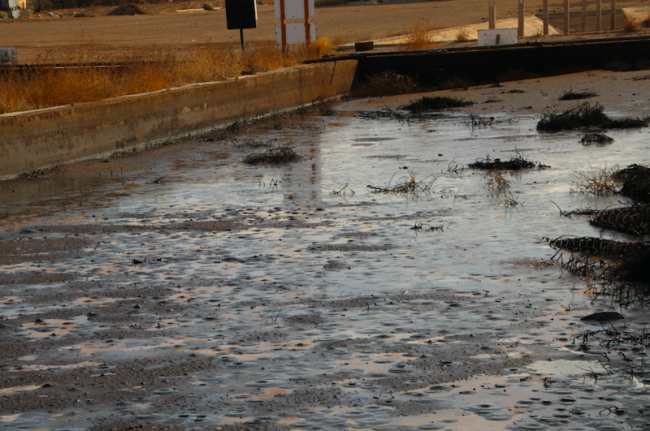
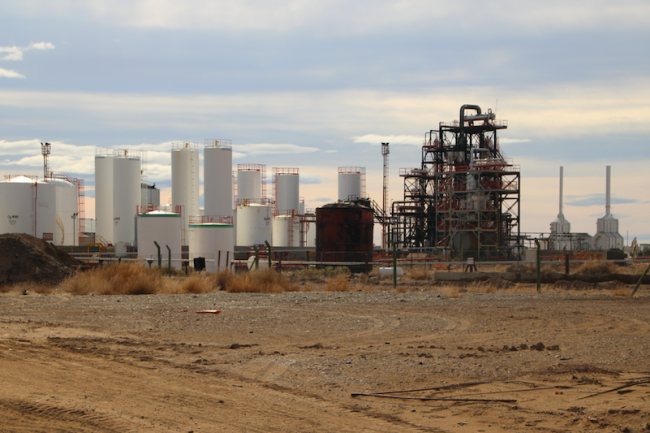
Similarly, at the site of an August 2022 YPF pipeline spill in the shale-rich Loma Campana, a Patagonia oilfield surrounded by landscapes of hardrock buttes and tableland formations, an abandoned bucket of oil testified to a strikingly incomplete “cleanup” process. Indigenous leaders noted that oil spills have been on the rise.
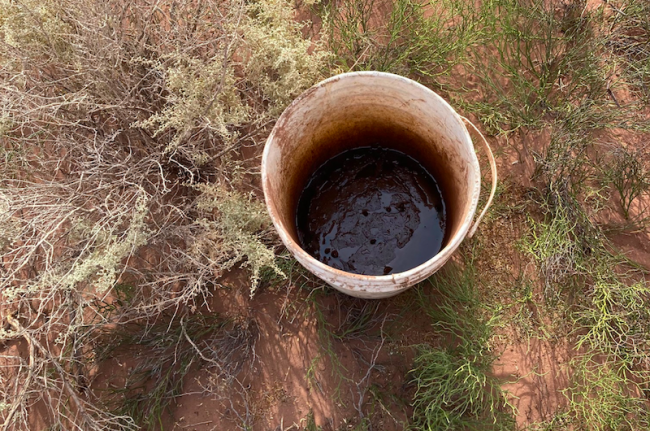

At Tecpetrol’s Fortin de Piedra field, we registered dozens of optical gas images that visualize methane and volatile organic compounds not seen with bare eyes. Tecpetrol is a private company that has most benefited from government subsidies. According to a 2022 FARN report, Tecpetrol received 46 percent of all national subsidies for the production of natural gas in 2021 ($465 million), even though it reported an investment of $189 million in Argentina that year.
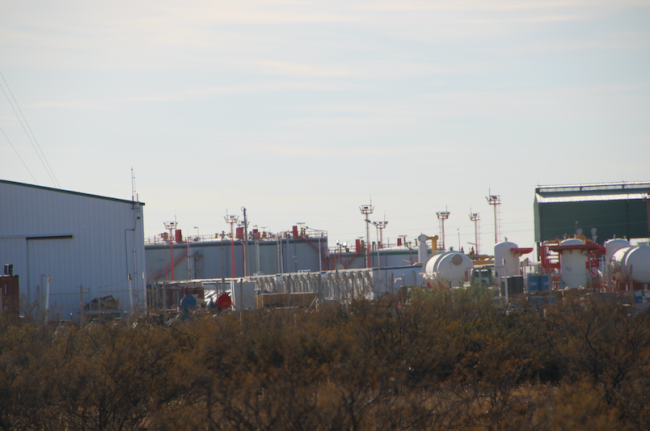
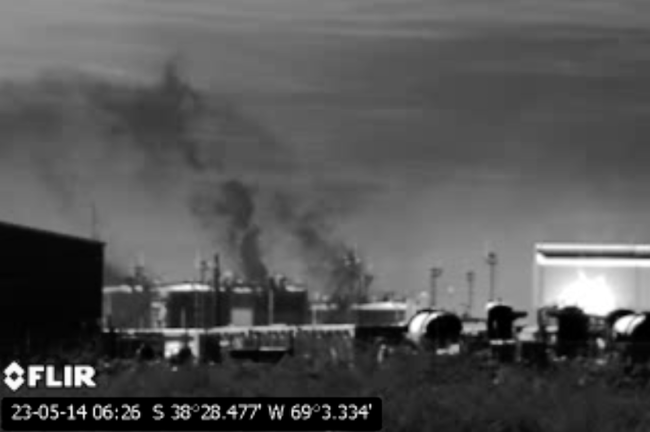
Pushing Back Against El Dorado
For Lefxaru Nawel, a vocero (spokesperson) and lawyer for the Neuquén Mapuche Confederation, fracking is a complex issue that is intertwined with other longstanding concerns. “The question should not be around a ‘yes’ or ‘no’ on fracking, which is the debate companies want us to have,” Nawel told journalists visiting Vaca Muerta. “But rather about ‘fracking for what, and for whom?’ These are the questions to ask, and they are not simple.”
Nawel continued: “For centuries, we have faced genocide, judicial trials, and sentences. So let’s be clear that these are decisions we are being asked to make at a time when we are not free. Many groups and organizations that work here are not discussing how we can break this dependence [on oil and gas] that we haven’t chosen.” He pointed to movements in Ecuador, Bolivia, and Peru that have defined the terms of debate through their demands, such as pushing conversations about civil society control over the price of gas and the phasing out of fossil fuels. “Here, we always talk [in media, public, and government discourses] in such abstract terms,” he lamented.
Mapuche leaders have resisted displacement since oil and gas operations began in the region, often leading marches and road blockades aimed at defending their rights and the communal aspect of the land targeted for extraction. Even before fracking began in 2013, Vaca Muerta represented a lifeline for foreign investment in conventional oil extraction and thus revenues for Argentina. Key decisions were made in the name of financial stability, energy self-sufficiency, paying foreign debt, and other concerns. In July 2013, shortly after the announcement of a new discovery of shale gas deposits in Neuquén, President Fernández de Kirchner passed the so-called “Chevron decree” allowing companies that extracted and exported oil and gas from Vaca Muerta to do so without paying taxes and without the usual requirement of repatriation of their foreign exchange earnings.
Oil giants like Chevron, Total Energies, Pan American Energy, Petrobras, YPF, Apache, and others almost immediately flooded into the region. In the Loma La Lata oilfield alone, the government handed out concessions with plans to drill around 1,500 wells. YPF, for instance, went from having four perforation towers and 42 productive wells in the region in 2012 to 19 towers and 290 wells by the end of 2014. In 2012, Total Energies—then the second largest gas extraction company in Argentina—received concessions inside the Auca Mahuida nature reserve. The zone was declared a protected area in 1996 with the goal of preserving the Patagonian grassland landscape, wildlife, biodiversity, and archeological and Mapuche ancestral sites.
In recent years, Mapuche communities have called for relevamiento territorial or territorial surveying, which would require regional and national authorities to recognize the past, present, and future rights of several Indigenous communities to communal ownership of land in the Vaca Muerta region. Argentina’s Law 26160, originally passed in 2006, created a process for the territorial mapping of Indigenous communal lands. But as of 2021, the government had carried out only 42 percent of this national mapping. At the same time, drawing on the International Labor Organization’s Convention 169, Mapuche communities have demanded respect for their international right to consultation and free, prior, and informed consent for any development processes that affect them.
Mobilizing strategies often yield important victories. According to Nawel, Indigenous resistance often forces companies to give up and drill elsewhere instead of on their lands. One of the Neuquén Mapuche Confederation’s latest judicial actions has been a joint lawsuit alongside human rights and environmental groups against extensive contamination by Comarsa, a sanitation company that holds toxic disposal contracts with petroleum giants like Exxon, Shell, Pluspetrol, YPF, and others. The plaintiffs allege that the toxic materials in Comarsa facilities in Añelo and in the Industrial Park in Neuquén exceed permitted limits and have not undergone promised air and soil contamination remediation, thus contributing to negative health impacts on nearby residents.
Non-Indigenous communities are also fighting back, in the streets and in the courts. In Ingeniero White and Bahía Blanca, a coastal epicenter of the refinery and petrochemical industry more than 350 miles east of Vaca Muerta, years of environmental damage are set to be compounded by boosted LNG exports. Back in August 2000, two separate incidents of huge escapes of chlorine and ammonia from petrochemical plants spurred residents into action. “It was next to schools and homes,” recalled Montserrat Gayone, a former elementary school teacher and member of the Environment and Labor Conditions Committee of the Argentine Workers Central (CTA) union. “We had a lot of support from the teachers’ union [and] we mobilized.” Now, a megaproject is underway that includes the construction of a gas pipeline from Vaca Muerta to Bahía Blanca and expansion of the port areas in Bahía Blanca and Ingeniero White. In 2017, Pampa Energy renovated a thermoelectric power plant in Ingeniero White with six state of the art dual fuel (gas and oil) engines. Six years later, optical gas images show extensive methane and volatile organic compound plumes being emitted from the plant’s stacks.
“Today the dispossession of lands continues,” said Gayone. “The government continues to grant land concessions to corporations, now for instance in places where the companies can liquify gas for exports. The population is forced out.”


Transcending the Discourse: Community-led Just Energy Transition
Environmental activists and scholars in Argentina are now also calling attention to the problem of green colonialism, especially with the turn to lithium in places like Jujuy, Catamarca, and Salta. “This [type of] energy transition is not ours,” writes Argentine environmental lawyer Enrique Viale. “[It] only takes into account the Global North, without concern for what happens on our lands.”
Yet there are alternatives, especially if we pay attention to on-the-ground research and discussions about the just energy transition. A recent publication by a team of researchers led by scientist Gabriel Blanco (a participant in the 2023 Intergovernmental Panel on Climate Change Synthesis Report) presents several viable scenarios for Argentina to transition away from fossil fuel dependence by 2040 or 2050—without turning to hydroelectric or nuclear power, but increasingly turning to wind and solar energy production.
The researchers compare five scenarios. One scenario is based on current policies. Other scenarios encompass partial and complete diversification of energy sources with 2040 and 2050 targets and the goal of significant greenhouse gas emissions reductions. The researchers conclude that any of the four alternative paths would significantly reduce the impact of energy generation on water, soil, and air throughout the country. They also find that a steadfast investment in renewable energy sources would not only easily supply the energy used throughout the nation, but also do so more equitably and at less cost than the current trajectory. Shifting oil and gas subsidies to the creation of infrastructure for renewable energy would give impetus for these alternatives, according to the report.
On-the-ground mobilizing holds hope for significant change, especially in a country with deep traditions of collective popular decision-making. Indigenous and non-Indigenous leaders in Neuquén and beyond are starting to engage diverse sectors, including religious groups, in discussing local plans around just energy transition where communities lead in these matters.
“We do this because we all need to become conscious, to propose these urgent discussions, to decide how we want to live, how we want to diversify the energy mix,” explained Nawel of the Neuquén Mapuche Confederation. “We need to go beyond the resistance to contamination… We are going to call labor unions, student movements, feminist movements, and human rights groups to a discussion of just transition because sometimes we don’t express our [informed] opinion.” The government-led energy transition, he added, “ends up being a pillage by the corporations.”
Argentine policy makers continue to race toward extracting oil and gas, allegedly to keep the nation afloat and affluent. This trend will only accelerate under Milei’s administration, which has so far embraced market-appeasing measures and promised to eliminate the Environment Ministry. But reckoning with these decisions is needed. The elements of people-led just energy transition are there, and growing. That might just be the rational thing to turn our sights to.
Patricia Rodríguez works as International OGI (Optical Gas Imaging) Analyst and Advocate at Earthworks. OGI is an infrared technology that detects fugitive and poorly combusted emissions of methane and volatile organic compounds from the gas and oil industry.

